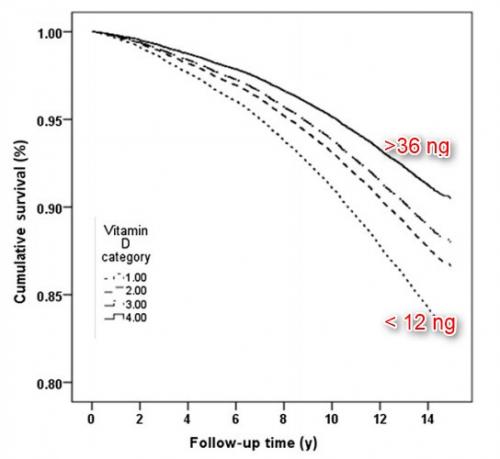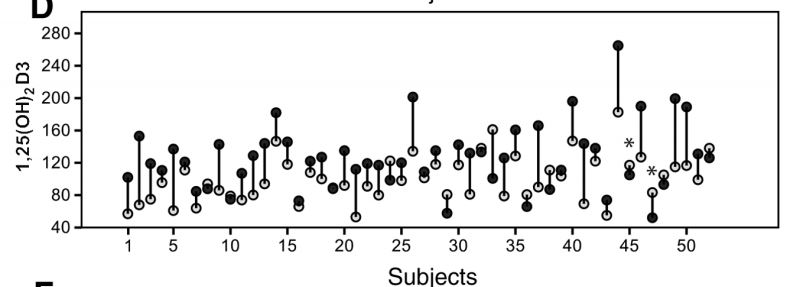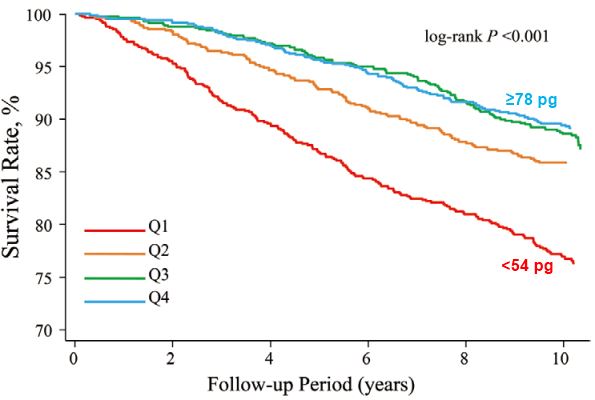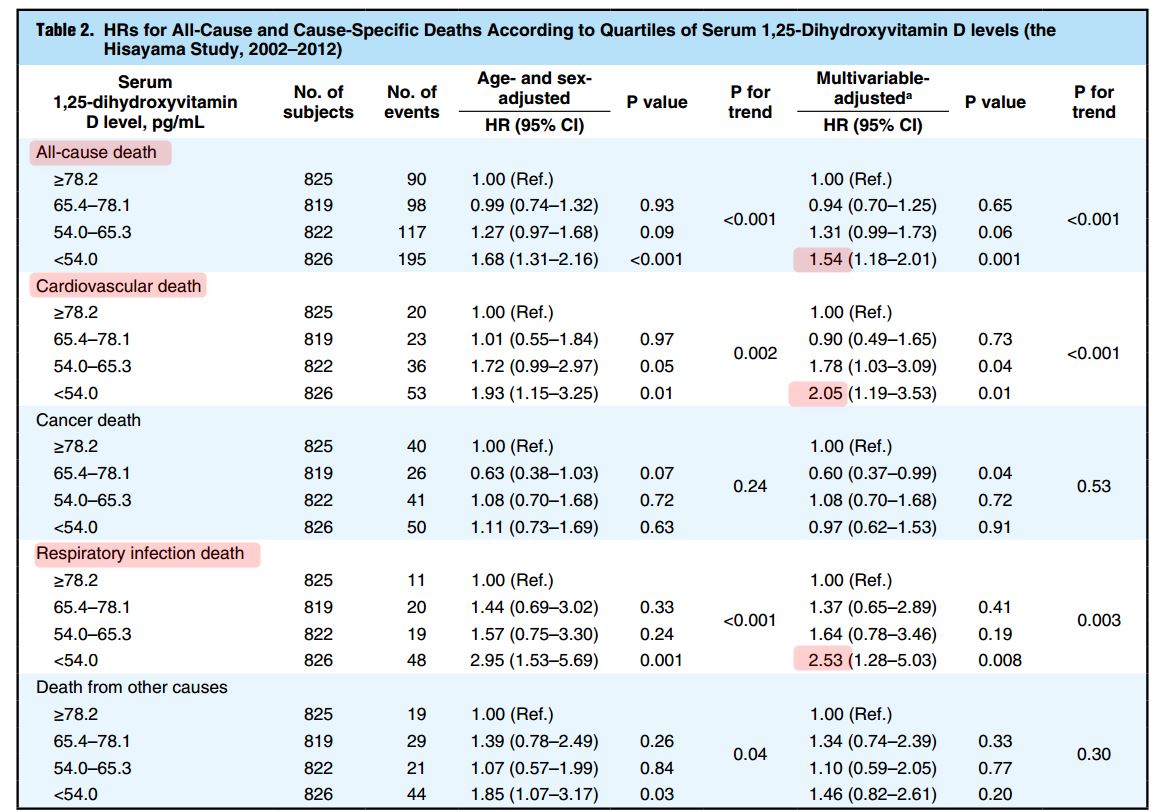Association Between Serum Vitamin D and All-Cause and Cause-Specific Death in a General Japanese Population - The Hisayama Study.
Circ J. 2017 Apr 20. doi: 10.1253/circj.CJ-16-0954. [Epub ahead of print]
- 2.4 times more likely to die if low Vitamin D (11,000 people for 14 years) – Sept 2016
- Chance of dying of various conditions reduced by higher levels of vitamin D – May 2015
- Much more likely to live longer if higher vitamin D – 27,000 seniors Feb 2017
- Chance of dying in hospital cut in half by just 10 ng higher level of Vitamin D – April 2016
- US people pay more for health care and die sooner (Vitamin D could help) - Aug 2016
- Taking vitamin D extends life - 56 trials with 100,000 people - Dr. Greger video July 2016
- The Nutrient That Could Save One Million Lives (vitamin D) - Nov 2015
- Dr. Grant on vitamin D and mortality in VitaminDWiki
Mortality category listing has 320 items along with related searches and the following chart

Note: This curent study looks at ACTIVE vitamin D
The following chart shows that active vitamin D does increase with 100,000 IU of vitamin D.
Notice the variability of response between individuals.

Calcitriol category listing has 62 items along with related searches
Genes which regulate active vitamin D worsen with age – Oct 2016
Also, poor kidney function can also reduce active vitamin D (calcitriol)
Download the PDF from VitaminDWiki


Umehara K1,2, Mukai N1, Hata J1, Hirakawa Y1, Ohara T3, Yoshida D1, Kishimoto H1, Kitazono T4, Hoka S2, Kiyohara Y5, Ninomiya T1.
- 1 Department of Epidemiology and Public Health, Graduate School of Medical Sciences, Kyushu University.
- 2 Department of Anesthesiology and Critical Care Medicine, Graduate School of Medical Sciences, Kyushu University.
- 3 Department of Neuropsychiatry, Graduate School of Medical Sciences, Kyushu University.
- 4 Department of Medicine and Clinical Science, Graduate School of Medical Sciences, Kyushu University.
- 5 Hisayama Research Institute For Lifestyle Diseases.
BACKGROUND:
Few studies have investigated the association between serum vitamin D levels and mortality in general Asian populations.
Methods and Results:
We examined the association of serum 1,25-dihydroxyvitamin D (1,25(OH)2D) levels with the risk of all-cause and cause-specific death in an average 9.5-year follow-up study of 3,292 community-dwelling Japanese subjects aged ≥40 years (2002-2012). The multivariable-adjusted hazard ratio (HR) for all-cause death increased significantly with lower serum 1,25(OH)2D levels (HR 1.54 [95% confidence interval, 1.18-2.01] for the lowest quartile, 1.31 [0.99-1.73] for the 2nd quartile, 0.94 [0.70-1.25] for the 3rd quartile, 1.00 [Ref.] for highest quartile; P for trend <0.001). A similar association was observed for cardiovascular and respiratory infection death (both P for trend <0.01), but not for cancer death or death from other causes. In the stratified analysis, the association between lower serum 1,25(OH)2D levels and the risk of respiratory infection death was stronger in subjects with an estimated glomerular filtration rate (eGFR) <60 mL/min/1.73 m2 than in those with eGFR ≥60 mL/min/1.73 m2; there was a significant heterogeneity in the association between eGFR levels (P for heterogeneity =0.04).
CONCLUSIONS:
The findings suggested that a lower serum 1,25(OH)2D level is a potential risk factor for all-cause death, especially cardiovascular and respiratory infection death, in the general Japanese population, and that lower serum 1,25(OH)2D levels greatly increase the risk of respiratory infection death in subjects with kidney dysfunction.
PMID: 28428487 DOI: 10.1253/circj.CJ-16-0954
Low active vitamin D increases chance of adult death by 50 percent in Japan – April 2017
7106 visitors, last modified 23 Apr, 2017,
(Cached)
Printer Friendly
Follow this page for updates
This page is in the following categories (# of items in each category)
Attached files
ID
Name
Uploaded
Size
Downloads
7931
All cause Japan T1.jpg
admin 22 Apr, 2017
162.86 Kb
726
7930
All cause Japan.jpg
admin 22 Apr, 2017
24.99 Kb
724
7929
All-cause death in Japan.pdf
admin 22 Apr, 2017
573.31 Kb
889
Note: This curent study looks at ACTIVE vitamin D
The following chart shows that active vitamin D does increase with 100,000 IU of vitamin D.
Notice the variability of response between individuals.
Calcitriol category listing has 62 items along with related searches
Genes which regulate active vitamin D worsen with age – Oct 2016
Also, poor kidney function can also reduce active vitamin D (calcitriol)
Download the PDF from VitaminDWiki


Umehara K1,2, Mukai N1, Hata J1, Hirakawa Y1, Ohara T3, Yoshida D1, Kishimoto H1, Kitazono T4, Hoka S2, Kiyohara Y5, Ninomiya T1.
- 1 Department of Epidemiology and Public Health, Graduate School of Medical Sciences, Kyushu University.
- 2 Department of Anesthesiology and Critical Care Medicine, Graduate School of Medical Sciences, Kyushu University.
- 3 Department of Neuropsychiatry, Graduate School of Medical Sciences, Kyushu University.
- 4 Department of Medicine and Clinical Science, Graduate School of Medical Sciences, Kyushu University.
- 5 Hisayama Research Institute For Lifestyle Diseases.
BACKGROUND:
Few studies have investigated the association between serum vitamin D levels and mortality in general Asian populations.
Methods and Results:
We examined the association of serum 1,25-dihydroxyvitamin D (1,25(OH)2D) levels with the risk of all-cause and cause-specific death in an average 9.5-year follow-up study of 3,292 community-dwelling Japanese subjects aged ≥40 years (2002-2012). The multivariable-adjusted hazard ratio (HR) for all-cause death increased significantly with lower serum 1,25(OH)2D levels (HR 1.54 [95% confidence interval, 1.18-2.01] for the lowest quartile, 1.31 [0.99-1.73] for the 2nd quartile, 0.94 [0.70-1.25] for the 3rd quartile, 1.00 [Ref.] for highest quartile; P for trend <0.001). A similar association was observed for cardiovascular and respiratory infection death (both P for trend <0.01), but not for cancer death or death from other causes. In the stratified analysis, the association between lower serum 1,25(OH)2D levels and the risk of respiratory infection death was stronger in subjects with an estimated glomerular filtration rate (eGFR) <60 mL/min/1.73 m2 than in those with eGFR ≥60 mL/min/1.73 m2; there was a significant heterogeneity in the association between eGFR levels (P for heterogeneity =0.04).
CONCLUSIONS:
The findings suggested that a lower serum 1,25(OH)2D level is a potential risk factor for all-cause death, especially cardiovascular and respiratory infection death, in the general Japanese population, and that lower serum 1,25(OH)2D levels greatly increase the risk of respiratory infection death in subjects with kidney dysfunction.
PMID: 28428487 DOI: 10.1253/circj.CJ-16-0954
Low active vitamin D increases chance of adult death by 50 percent in Japan – April 2017
7106 visitors, last modified 23 Apr, 2017,
(Cached)
Printer Friendly
Follow this page for updates
This page is in the following categories (# of items in each category)
Attached files
ID
Name
Uploaded
Size
Downloads
7931
All cause Japan T1.jpg
admin 22 Apr, 2017
162.86 Kb
726
7930
All cause Japan.jpg
admin 22 Apr, 2017
24.99 Kb
724
7929
All-cause death in Japan.pdf
admin 22 Apr, 2017
573.31 Kb
889
Genes which regulate active vitamin D worsen with age – Oct 2016
Also, poor kidney function can also reduce active vitamin D (calcitriol)
Download the PDF from VitaminDWiki
Umehara K1,2, Mukai N1, Hata J1, Hirakawa Y1, Ohara T3, Yoshida D1, Kishimoto H1, Kitazono T4, Hoka S2, Kiyohara Y5, Ninomiya T1.
- 1 Department of Epidemiology and Public Health, Graduate School of Medical Sciences, Kyushu University.
- 2 Department of Anesthesiology and Critical Care Medicine, Graduate School of Medical Sciences, Kyushu University.
- 3 Department of Neuropsychiatry, Graduate School of Medical Sciences, Kyushu University.
- 4 Department of Medicine and Clinical Science, Graduate School of Medical Sciences, Kyushu University.
- 5 Hisayama Research Institute For Lifestyle Diseases.
BACKGROUND:
Few studies have investigated the association between serum vitamin D levels and mortality in general Asian populations.
Methods and Results:
We examined the association of serum 1,25-dihydroxyvitamin D (1,25(OH)2D) levels with the risk of all-cause and cause-specific death in an average 9.5-year follow-up study of 3,292 community-dwelling Japanese subjects aged ≥40 years (2002-2012). The multivariable-adjusted hazard ratio (HR) for all-cause death increased significantly with lower serum 1,25(OH)2D levels (HR 1.54 [95% confidence interval, 1.18-2.01] for the lowest quartile, 1.31 [0.99-1.73] for the 2nd quartile, 0.94 [0.70-1.25] for the 3rd quartile, 1.00 [Ref.] for highest quartile; P for trend <0.001). A similar association was observed for cardiovascular and respiratory infection death (both P for trend <0.01), but not for cancer death or death from other causes. In the stratified analysis, the association between lower serum 1,25(OH)2D levels and the risk of respiratory infection death was stronger in subjects with an estimated glomerular filtration rate (eGFR) <60 mL/min/1.73 m2 than in those with eGFR ≥60 mL/min/1.73 m2; there was a significant heterogeneity in the association between eGFR levels (P for heterogeneity =0.04).
CONCLUSIONS:
The findings suggested that a lower serum 1,25(OH)2D level is a potential risk factor for all-cause death, especially cardiovascular and respiratory infection death, in the general Japanese population, and that lower serum 1,25(OH)2D levels greatly increase the risk of respiratory infection death in subjects with kidney dysfunction.
PMID: 28428487 DOI: 10.1253/circj.CJ-16-0954
| 7106 visitors, last modified 23 Apr, 2017, |
| ID | Name | Uploaded | Size | Downloads | |
|---|---|---|---|---|---|
| 7931 | All cause Japan T1.jpg | admin 22 Apr, 2017 | 162.86 Kb | 726 | |
| 7930 | All cause Japan.jpg | admin 22 Apr, 2017 | 24.99 Kb | 724 | |
| 7929 | All-cause death in Japan.pdf | admin 22 Apr, 2017 | 573.31 Kb | 889 |